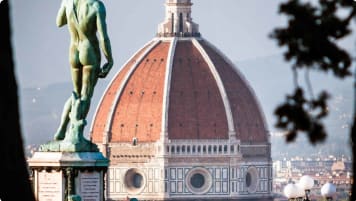About Malta, Sicily, Sardinia and Corsica: islands of the western Mediterranean
For senior and mature travellers taking a small group tour to Malta, Sicily, Sardinia and Corsica, this paper answers questions and provides the historical context of a small group tour for couples and solo travellers to the Historic Mediterranean sea.
25 Sep 19 · 15 mins read
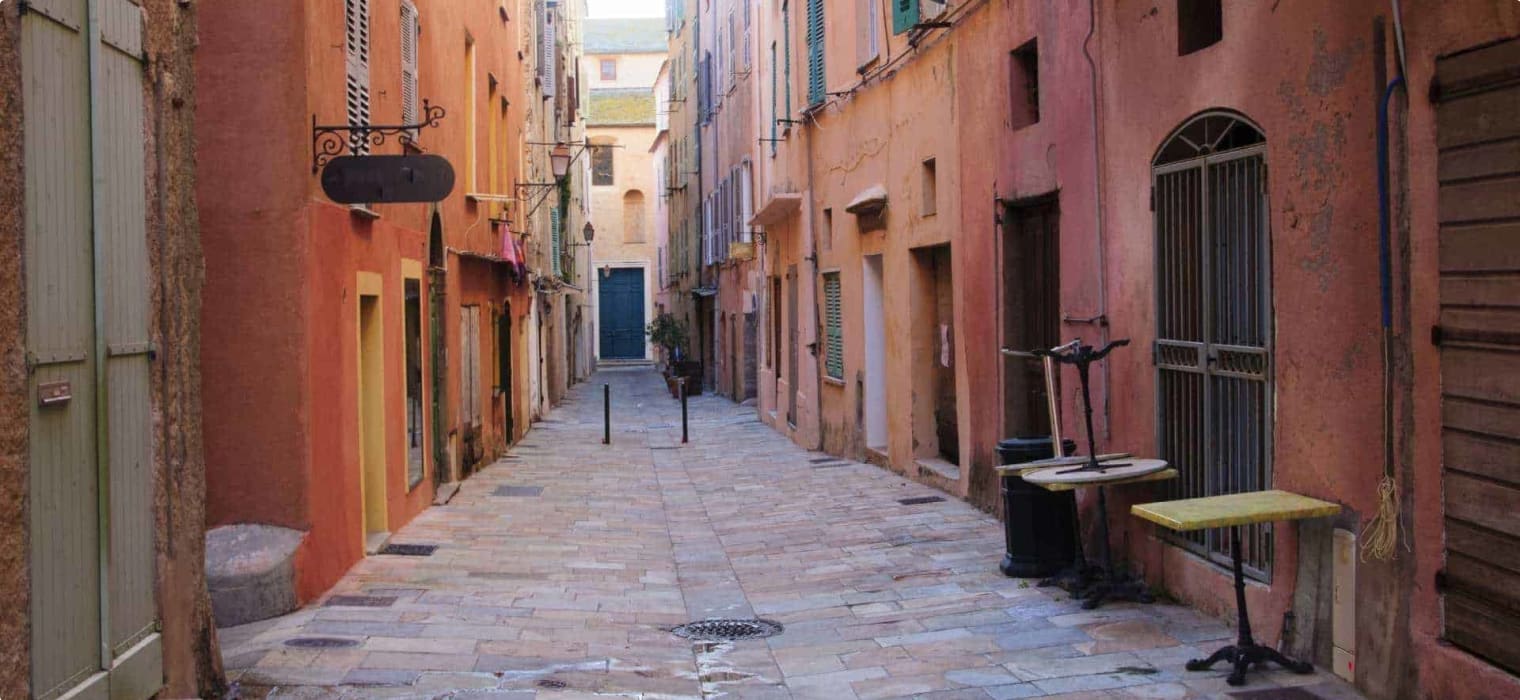
About Malta, Sicily, Sardinia and Corsica
Many civilisations and empires arose, flourished and declined around the shores of the Mediterranean. Its islands bear the marks of these, from the Phoenicians, Greeks and Romans, to the Arabs, Spanish, French and British. The western Mediterranean islands of Malta, Sicily, Sardinia and Corsica vary from sun-drenched rocky masses to fertile lands with rolling pastures, forested mountains, volcanoes and spectacular coastlines. Ancient peoples left temples, standing stones and forts here, and bays and inlets sheltered fishing and trading fleets for millennia. Journeying from one island to the next takes one along sea-routes traversed by Phoenicians, Greeks, Romans and Arabs, and more recently the Royal Navy. In this article, we will answer some frequently asked questions that travellers have about Malta, Sicily, Sardinia and Corsica , before an in-depth look at the key destinations and main highlights we explore on our small group Mediterranean tours to the Western Mediterranean.Related Tours
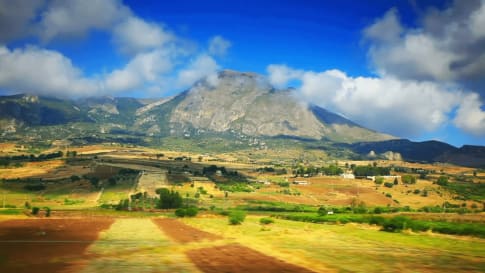
25 days
Apr, Sep, OctMediterranean Islands Small Group Tour | Malta, Sicily, Sardinia and Corsica
Visiting Corsica, Italy
For centuries Malta, Sicily, Sardinia and Corsica held the key to the Mediterranean. Unlike other European tour companies, Odyssey provides a tour leader and local guides to share detailed itineraries about the destinations on these small group journeys. This escorted tour of western Mediterranean explores the geography, history, culture and peoples of these 4 islands. Small group tour for mature couples and solo travellers. A reasonable single supplement is charged.
From A$19,750 AUD
View Tour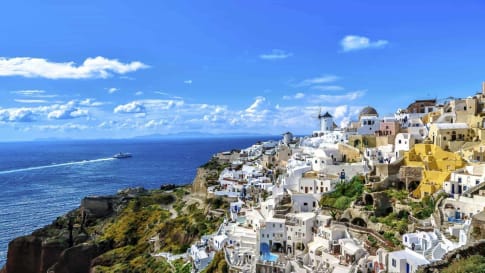
10 days
Apr, Oct, MarSantorini - Crete: Eastern-Mediterranean Islands Short tour
Visiting Greece
Join our small group short tour of the Eastern Mediterranean. Spend 10 days in Greece for a glimpse of the land of great philosophers, myths, and legends. We will learn about the culture and heritage of modern Greece while travelling from Athens to Santorini and over to Crete.
From A$9,375 AUD
View Tour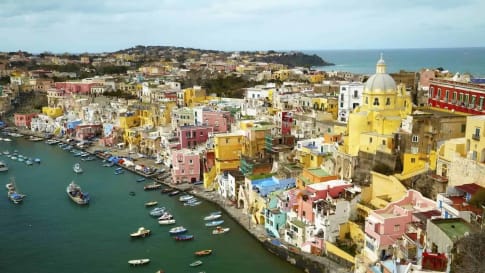
22 days
Jan, Apr, SepAncient History of Southern Italy & Sicily group tours
Visiting Italy
Our program for senior travellers, as well as featuring the rugged countryside of Southern Italy, also encompasses learning about the many civilisations that have shaped this land. We learn about the influence of the early Phoenicians, Greeks, Romans, Byzantines, Saracens, and Aragonese.
From A$16,995 AUD
View TourCommon threads, unique aspects of these Mediterranean Islands
The history of these four Mediterranean islands has a number of common threads, and each possesses many unique aspects that are explored on these Mediterranean tours. It is the Mediterranean sea though that gave the power with the islands providing resource to facilitate the merchants of Venice, the traders of North Africa and the occupants of Rome to stamp their mark on the history on each Mediterranean Island over time to create the fairy tale villages so often in the travel guide books, but for an Odyssey traveller we seek to take our traveller beyond the destination into the history and stories in the ancient ruins and medieval alleyways that create the Italian culture and that of the Mediterranean culture we experience today as we explore each Mediterranean Island from Sardinia to Malta and then the Corsica to Sicily ferry.
Malta withstood two tremendous sieges during its history due to its strategic location. In 1565, the Knights of St. John Hospitaller held out against the Ottomans, who were threatening Europe. Furthermore, in WW2, the island held out for three years against the Germans and Italy and earned the George Cross for bravery. Sicily’s natural resources and central position made it a great prize for ambitious states and rulers. Once a centre of Greek civilisation, it became an important Roman then Byzantine province. The Arabs arrived in the 9th century, then the Normans in the 11th century.
Visiting Sardinia and Corsica
The ancient world knew Sardinia for its obsidian, traded throughout the region to make sharp tools and arrowheads. Phoenicians, Carthaginians, Romans, Vandals, Byzantines, Arabs, Spaniards as well as Italians all conquered the island.
Corsica also has a similarly turbulent past, as a bone of contention between rival city-states. Rebellion against Genoese rule finally led to the establishment of a republic. However, French troops arrived in overwhelming numbers when Genoa sold her remaining Corsican towns to France. This history when planning a trip to Corsica should form part of the itinerary of a good Corsica tour.
Tours of Malta
The tiny Republic of Malta is right in the heart of the Mediterranean, midway between Sicily and Tunisia. Farmers have cut much of Malta’s rocky landscape into terraces for farming, and fishing and seafaring remain important. Malta is also exploiting its sunshine and beaches, and above all its history, attracting tourists and film-makers. For Odyssey travellers on a small group tour a Corsica trip tends to be history based around the old town and the Musee de la Corse, rather than fabulous beaches, scuba diving and a boat trip. Don’t miss these highlights when planning a trip to Corsica for inclusion in the itinerary:
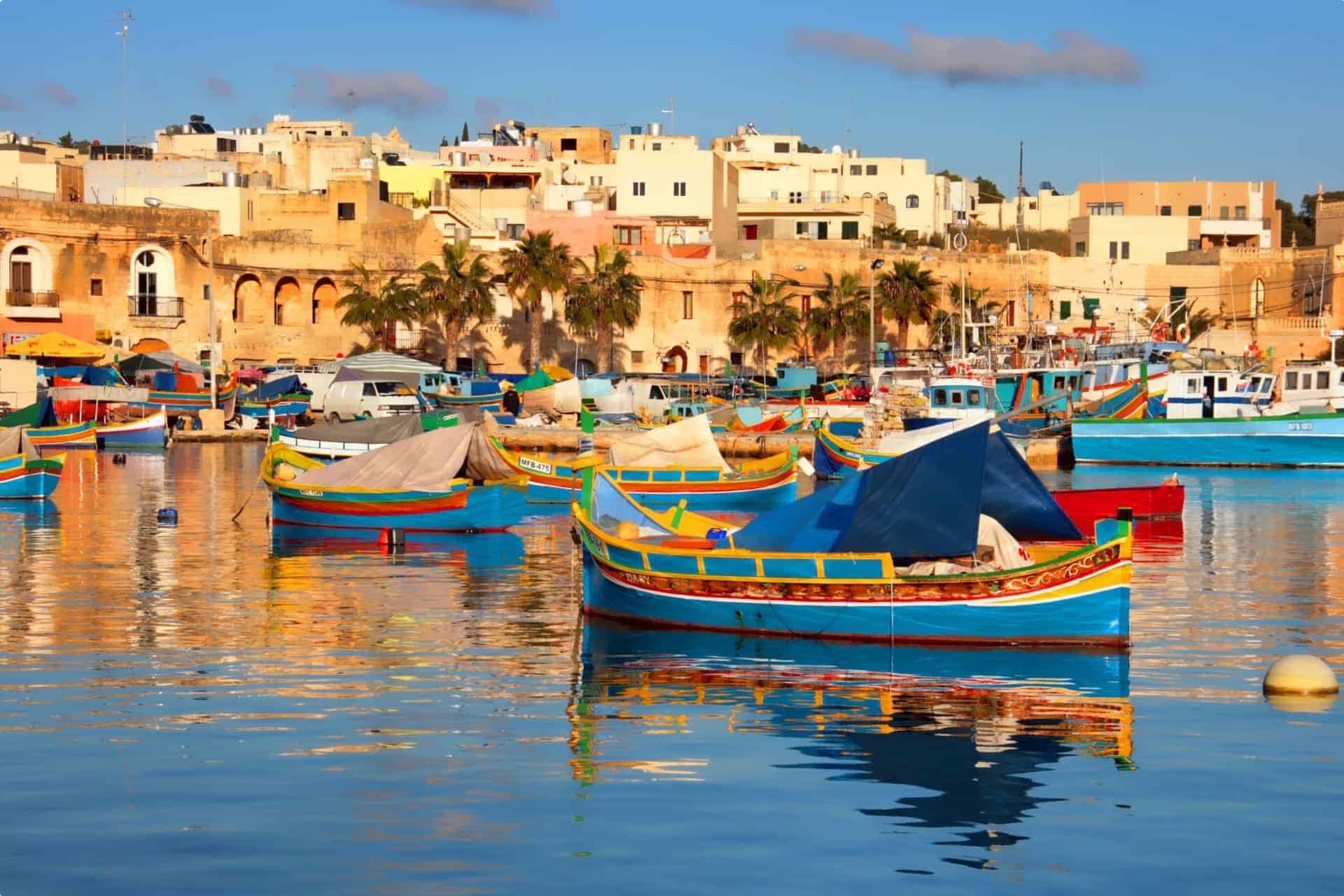
Valletta, the capital
Tours to Malta must include its capital, Valletta, one of the first planned cities in all of Europe. Despite measuring only 900 by 630 metres, Valletta boasts over 25 churches, making it a testament to the strength of Catholicism. Pope Pius V’s military engineer, Francesco Laparelli, drew up the plans for the city and its defences. When visiting Valletta, don’t miss:
- John’s Co-Cathedral and its magnificent Baroque interior. Caravaggio, the Italian master painter, painted several works for this spiritual headquarters of the Knights.
- The Grandmaster’s Palace has one of the largest armouries in the world. The Hall of the Supreme Council of the Knights of St John is found here.
- Fort St Elmo, rebuilt after its destruction by the forces of Suleiman I during the Great Siege in 1565.
- The Auberges, the inns of residence of the Knights of St John.
- The ‘Malta Experience’, an audio visual show chronicling Malta’s rich history, set in a purpose built panoramic auditorium.
- Renzo Piano’s City Gate, Opera House and Parliament building.
Highlights of Malta travel
- Mdina, the ‘silent city’, Malta’s ancient capital and arguably one of the best examples of a medieval city in Europe. Malta’s nobility lived here, consequently it was known as the Città Notabile. In 1090, Count Roger decreed a cathedral should be built here to re-establish Christian worship and teaching. This was built above a ruined sanctuary where Publius, the Roman governor of Malta, once had his house. Publius is famous for greeting St Paul when the apostle was shipwrecked here in 60 CE. The great earthquake of 1693 destroyed the cathedral, but it was soon replaced in the Roman Baroque style with a magnificent dome.
- Rabat, an extension of Mdina, is separated by an Arab wall and ditch. It contains Malta’s oldest church, early Christian catacombs and the Museum of Roman Antiquities.
- The little town of Mosta is famous for the Parish Church of Santa Maria (aka the Mosta Dome). An older church remained in use during the Dome’s construction. The parishioners provided most of the funds and much of the labour. Mosta also has the Victoria Lines, 12 kms of fortifications built by the British in the late 19th century.
- The Hal Saflieni Hypogeum is a subterranean necropolis thought to date from around 3600 to 3600 BCE. In 1902, construction workers stumbled upon what appeared to be an underground sanctuary. Archaeologists subsequently found a massive underground structure consisting of three levels carved into stone.
- Malta’s stone age farmers built over 50 massive temples, including the Tarxien temples, between 3600 and 2500 BCE. Their interiors have intricately carved decorations of animals, snakes, fish, spirals and dots.
- The Ghar Dalam cave, the ‘cave of darkness’, is an archaeological site some 500,000 years old. Excavations here yielded remains of animals suggesting Malta was once joined to Italy, but not northern Africa.
Gozo
Mediterranean Tours to Malta should also take in Gozo, the second largest island of Malta. Its tightly-packed hilltop villages and little fortified farmhouses are the legacy of slave-snatching raids by Barbary corsairs. The main town, Victoria, is a maze of little streets, old stone balconies and religious shrines. The main sights to see in Gozo include:
- The massive walls and bastions of the citadel, Il-Kastell. Philip II of Spain donated money for its building. It contains the Palace of the Governors, the cathedral, Folklore Museum, and a nobleman’s palace, now the Archaeological Museum. The citadel’s ramparts provide a panoramic view across the water to Malta, and on a clear day, even Sicily.
- The stone age temple complex of Ggantija, the oldest of all the Maltese temples, dating from 3600 to 3200 BCE. These are the oldest free-standing stone edifices on earth, pre-dating the pyramids of Egypt and the Mycenaean temples on Crete.
- The origin of the Ta Pinu Basilica is unknown, but the first records of the chapel date back to 1534. A delegate of the Pope closed the church in 1575 as it was in a bad state of repair. He also gave orders for the shrine to be demolished. However, according to legend, the first blow with the pick broke the worker’s arm. This was understood as a divine message, and accordingly, the chapel was saved.
Odyssey offers tours of Malta
Malta tours are included in two of Odyssey’s escorted tour programs to the islands of the western Mediterranean. The first includes the guided tour of Malta, Sicily, Sardinia and Corsica. This Mediterranean islands small group tour is perfect for the mature traveller looking to enjoy small group Malta travel. Our other guided tour is Caravaggio’s journey, an escorted small group tour of Malta, Sicily and mainland Italy. This tour follows in the footsteps of this brilliant but troubled Italian painter, Caravaggio. Born Michelangelo Merisi in the city of Milan in 1571, Caravaggio became one of the most famous painters of his time and one of the most influential. Unlike the cruise ships which go between Malta, Sicily and Sardinia, our tours take the local ferry from Sardinia to Maltaand return to give you an authentic and immersive experience of Mediterranean culture.
Sicily tours
Sicily is the largest Mediterranean island in the mediterranean sea. In medieval times it was the stepping stone between Europe and Africa. Phoenicians and Greeks, Carthaginians and Romans, Goths and Byzantines, Arabs and Normans, Germans, Spaniards and the French have all fought for its control. The island’s geography, topography and climate remain fixed, but Sicily’s art, architecture, cuisine, and religion altered with each conquest. If you’re planning a trip to Sicily, don’t miss the following!
Palermo, the capital
Palermo is flanked by the Tyrrhenian Sea on one side and Monte Pellegrino on the other. The city nestles in a natural amphitheatre called the Conca d’Oro (the Golden Seashell). Palermo’s beautiful setting, and its monuments and architecture, make it one of the most exciting and exotic Italian cities to visit. When in Palermo, don’t miss:
Highlights of Palermo
- The most magnificent monument in Palermo is the Norman Palace, Palazzo Normanni, and its Cappella Palatina, or Chapel Royal. The first Norman king, Roger II, blended Byzantine, Islamic and Romanesque styles of design and craftsmanship. It is adorned with mosaics as well as marble inlaid with gold, stone and glass. The walls and ceiling glow with vividly depicted scenes from the Bible.
- Monreale, the ‘royal mount’, where William II founded a cloistered monastery celebrated for its mosaics and adorned capitals.
- The Teatro Massimo, Palermo’s magnificent Opera House.
- Quatro Canti, the magnificent Baroque piazza.
- La Martorana, renowned for the Byzantine mosaics in its spectacular interior.
Other highlights of a Sicily tour
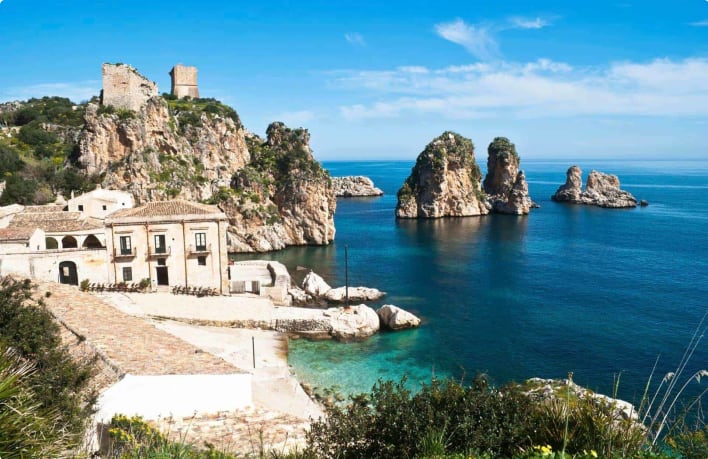
- Caltagirone, originally Arab, then Norman, then Ligurian. Today it’s one of Italy’s major ceramic production centres. Don’t miss the approach to the city’s Regional Museum of Ceramics. It comprises a network of ramps, steps and benches, adorned with panels and reliefs in colourful ceramic tiles.
- A devastating earthquake in 1693 flattened the town of Noto. Subsequently, its nobles rebuilt it into the finest Baroque town in Sicily. Now a UNESCO World Heritage Site, the town is most impressive in the early evening and at night. Don’t miss the San Franceso Church, the Monastery of Santa Chiara, the Duomo and the Palazzio Ducezio.
- Piazza Armerina is a half-medieval, half-baroque provincial town. It’s important for the early fourth century Roman mosaics in the Villa Romana del Casale, now a UNESCO World Heritage site. The floors of what remains of the villa have some of the finest surviving mosaics from Roman antiquity.
- Trapani once sat at the heart of a seaborne trading network stretching from Venice to Carthage. It was here that Peter of Aragon landed in 1282, beginning the Spanish occupation of Sicily. Its historic centre features 18th century Spanish Baroque architecture.
- Mozia is an ancient Phoenician town on a small island off the coast. To the Arabs it was Mars el’Allah, literally “Port of Allah”. The Whitaker family bought it in the late 1800s and subsequently made a fortune from the wine they made and named after the region — marsala. Joseph Whitaker also began archaeological digs on the island in 1913 and founded a museum for its finds.
- Take the funicular up to the spectacularly sited town of Erice. It’s possible to see the summit of Mt Etna at the other end of the island on a clear day.
Sicily’s Greek city-states
- Segesta is an archaeological site about 70 kilometres southwest of Palermo. Its ancient Greek temple is one of the best preserved Doric temples in the world. It also contains the ruins of a Norman castle, a small church, a mosque, and a classical theatre.
- Syracuse was the most powerful and important of all the Greek city-states. In its heyday, it was bigger than Corinth or Athens, and was the largest city in the ancient world. There are many reminders of the city’s Greek past. See the ancient quarter of Neapolis, the Teatro Greco, Temple of Apollo, the Ear of Dionysius, and the Arethusa Fountain. Also, don’t miss the city’s cathedral. The remains of the 5th century BCE temple of Athena were incorporated into a new Baroque structure in 1728.
- Splendidly situated, Taormina has snowcapped Mt Etna on one side and sandy beaches far below. It also offers glimpses of antiquity. Its famous Greek theatre was begun in the 3rd century BCE and rebuilt by the Romans.
- The Greeks built their lovely temples at Selinunte during the high classical period of the 5th century BCE. It subsequently became one of the great city-states of Magna Graecia. One of its temples rivals the Parthenon in Athens for size and beauty.
Odyssey offers small group Sicily tours.
Two of Odyssey’s tour programs to the islands of the western Mediterranean visit Sicily. The first also takes in Malta, Corsica and Sardinia. This Mediterranean islands small group tour is perfect for the mature traveller looking to discover Sicily and the other islands of the western Mediterranean. Or follow in the footsteps of the brilliant but troubled Italian painter, Caravaggio, on Caravaggio’s journey, an escorted small group tour of Malta, Sicily and mainland Italy. Born Michelangelo Merisi in the city of Milan in 1571, Caravaggio became one of the most famous painters of his time and one of the most influential.
Tours of Sardinia
There is evidence of human settlement in Sardinia from at least 150,000 years ago. A significant population of early agricultural villages evolved around 8000 BCE. Its prosperity was partly due to obsidian. This is a hard black glassy volcanic rock excellent for making sharp tools and arrow-heads. The Mediterranean peoples highly prized obsidian, and exported it throughout the region. Bronze Age Sards also mined, worked and exported copper. The most remarkable innovation in this era is the construction of the first nuraghe, circular defensive towers built of dressed stone. Over 7,000 still exist in Sardinia today. As well as the nuraghe, if you choose to travel to Sardinia, don’t miss the following sights:
Cagliari, the capital
Sardinia’s capital, Cagliari, stands on Sardinia’s best harbour, with an easily defensible hill above and a fertile plain behind. The picturesque Stampace quarter in the lower town is best known for the church dedicated to Cagliari’s patron, Sant’ Efisio. The fortified Castello contains a Pisan tower, a pink Baroque cathedral, and the 18th century university. Next to the cathedral stands the former viceroy’s palace, and on the highest point stands the Torre di San Pancrazio, dating around 1300. Nearby are the National Archaeological Museum and the Pinacoteca or art gallery.
Highlights of a trip to Sardinia
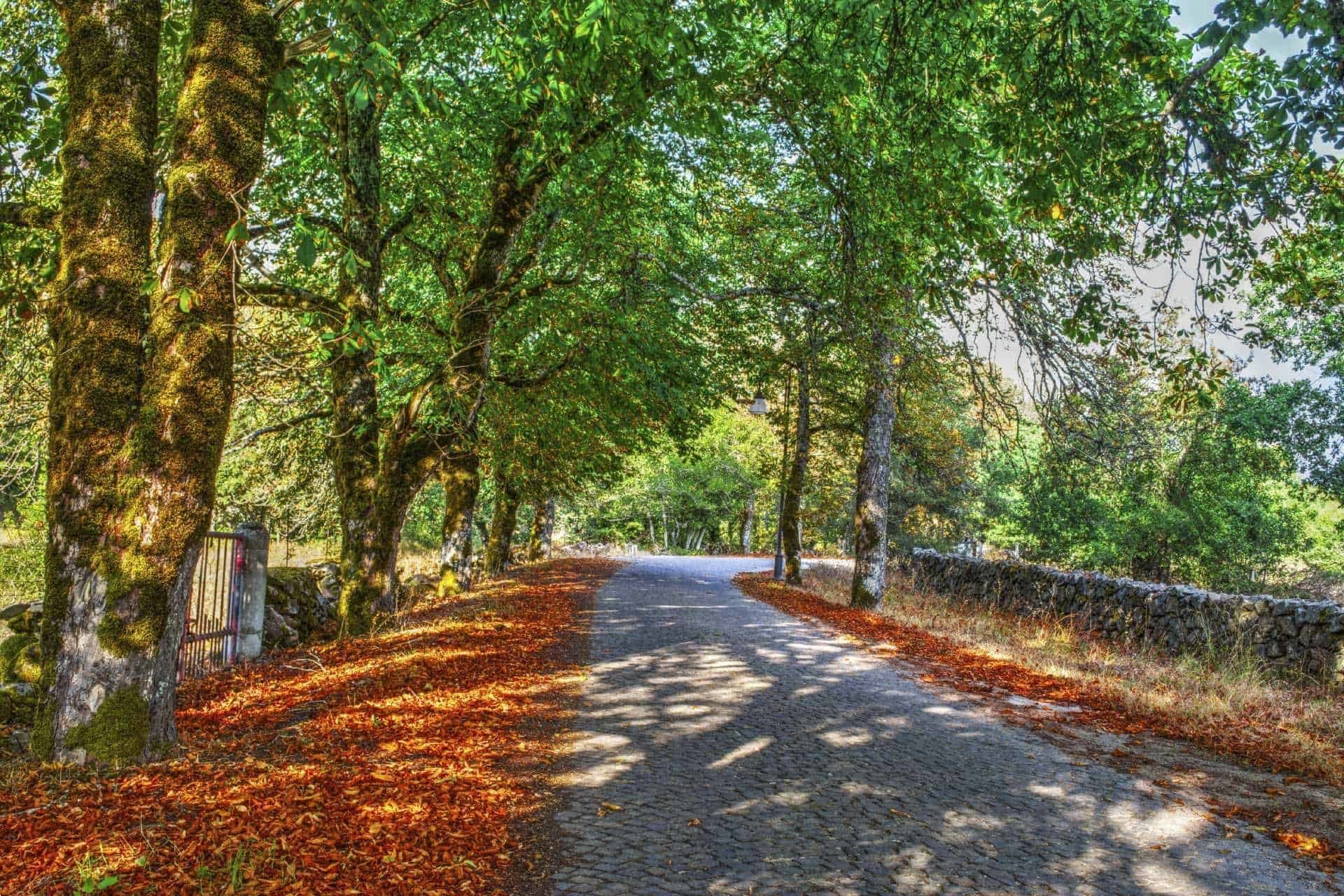
- Don’t miss Su Nuraxi du Barumini, the largest nuraghe site. It has four towers, a massive curtain wall, and a network of narrow passages and stairways. A cluster of round stone huts, forming a large village, tightly surrounds the whole tower.
- Nora is Sardinia’s best example of a Roman provincial city. It has paved streets over a sewage system, a forum, temples, a theatre, baths, and a medical centre dedicated to the Greek god of healing, Aesclepios.
- Driving around the wild and rocky Capo Spartivento and the southern coast, perfect for a day’s outing.
- Sailing around the Archipelago of La Maddalena. The archipelago is now a national park because of its natural beauty and rare flora and fauna. A small archaeological museum displays a Roman shipwreck.
- Explore Nuoro, set in a spectacular setting at the foot of Monte Ortobene. The old quarter is a charming maze of lanes and contains the Museum of Sardinian Life and Popular Traditions. This features clothing, jewellery, furniture, tapestries, musical instruments, carnival masks and figures used in traditional festivals.
- Drive around the Gennargentu Mountains, now a National Park. Its forests are the habitat of golden and Bonelli eagles, royal kites, European vultures, wild cats, boar and mouflon (mountain sheep).
- Visit Sassari, Sardinia’s second largest city. It still contains Catalan gothic palazzi and Baroque churches. The oldest, Santa Maria di Betlem, founded in 1106, is older than the town itself. The cathedral, San Nicola, was rebuilt in the 15th century in the Catalan Gothic style, and an exceptionally beautiful Baroque façade was added in the 18th century.
- Alghero overlooks a bay with lovely beaches, but perhaps its finest feature is its surviving medieval walls, especially the sea walls with their seven towers.
Tours of Corsica
Corsica lies about 150 kilometres southeast of the French mainland in the Mediterranean sea, 70 kilometres from mainland Italy, and 15 kilometres north of Sardinia. It has a high, craggy coastline, and a mountainous interior covered with forest and scrub (maquis), cut by fertile valleys. In Southern Corsica, Corsican farmers grow crops in the rich valley soils, including grapes, other fruit, vegetables, olives and tobacco. Sheep graze in the mountains – wool and cheese are important exports – and fishing produces sardines. The rugged scenery, wonderful sea views, beautiful beaches and colourful villages have made Corsica tours highly attractive. Don’t miss these highlights:
Ajaccio, the capital
Corsica‘s largest town has palm trees, cafés and yachts, and looks like a typical French Mediterranean resort. A citadel founded by the Bank of St George in 1492 overlooks the city. Since World War II, tourism has become Ajaccio‘s most important economic activity, largely because it’s the birthplace of the most famous Corsican ever – Napoleon. He was born in a grand mansion now called the Maison Bonaparte . It suffered many vicissitudes after the family vacated it hurriedly in 1793. The French government restored it after they finally acquired it in 1923. The lovely Palais Fesch Musee des Beaux Arts is also linked to Napoleon. Cardinal Joseph Fesch, Napoleon’s step-uncle, had a large collection of art which he bequeathed to the city.
Beautiful landscapes
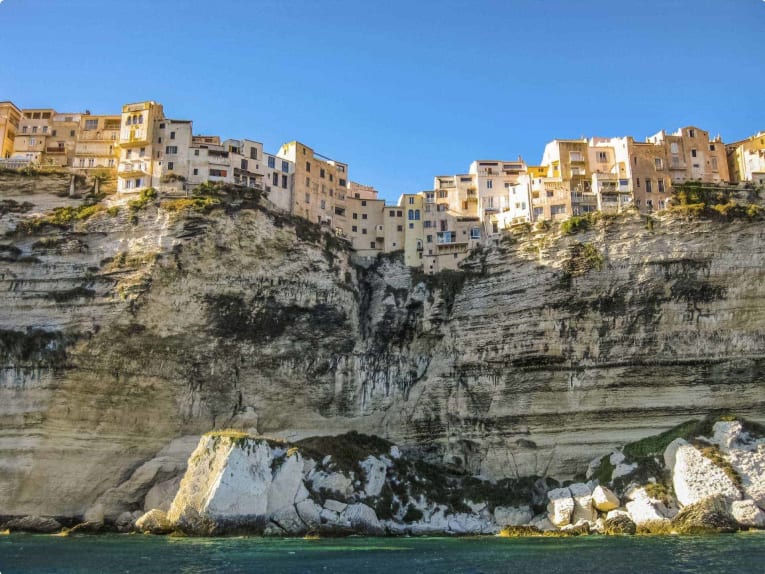
- The Golfe de Porto is one of Corsica’s most famous landscapes, and a UNESCO World Heritage site listed nature reserve. Visitors have the opportunity to see seagulls, cormorants and sea eagles. The clear waters, beautiful beaches , with their islets and inaccessible caves, host a rich marine life.
- Driving the picturesque road that follows the coast around the narrow mountainous peninsula of Cap Corse . It boasts spectacular cliff scenery with wonderful sea views, weathered watchtowers guarding its coves and fishing villages, and maquis covering the hillsides.
- Don’t miss a visit to Bonifacio. Built on a narrow peninsula, Bonifacio’s upper town rises above sheer cliffs, surrounded by immense fortifications. The upper town has a single entrance protected by eight gates and a drawbridge.
- Founded in the 5th century BCE by Greeks from Syracuse, Porto-Vecchio disappeared in the Dark Ages due to pirates and malaria. The Bank of St George rebuilt it in 1540. Porto-Vecchio is set on a magnificent harbour and is a busy port and holiday resort. The old town high above the port still has its Genoese walls.
- The Greeks, Carthaginians and Romans all used the port of Propriano, on the Golfe de Valinco. Its vulnerability to pirate raids led to its decline into a fishing village. It revived in the 19th century as a ferry and commercial port, and more recently as a tourist destination. Its main attractions are beautiful beaches, good sailing and diving sites.
- The little harbour of L’Ile Rousse, flanked by red porphyry rocks, has three sandy beaches and the mildest winters in Corsica. It resembles the French Riviera, with its plane trees and palms, covered market and restaurants, and games of boules. Just behind the little town are three charming old villages, all with Romanesque and Baroque churches and ruined castles.
Ancient historic sites
- Neolithic farmers occupied Filitosa from 6000 BCE, then invaders around 3500-3000 BCE created the first menhirs. When the torreens (towerbuilders) conquered Filitosa in about 1300 BCE, they destroyed most of the menhirs by incorporating them into the walls around the three towers they built. Therefore, Filitosa is one of the most important prehistoric sites in Europe.
- Calvi was originally a Roman port. The citadel’s ramparts and three mighty bastions loom over the harbour. Inside is the Genoese governor’s palace and the cathedral of St John the Baptist, rebuilt in 1570. With its yacht marina on the bay and snowcapped mountains in the background, Calvi now flourishes as a holiday resort.
- Often a refuge for bandits, Sartene was also notorious for vendettas until the mid-19th century. Visit the 16th century Hotel de Ville, formerly the palace of the Genoese governors. Behind it lies the old Santa Anna quarter, a web of alleys and steep steps. Its jumble of dark stone houses and noblemen’s mansions evoke medieval Corsica.
Other historic sites
- Corte was the capital of Corsica on three occasions. In 1765 Pasquale Paoli founded the island’s only university here, at the site of the proclamation of Corsica’s constitution. In the heart of the old town is Place Paoli, with a 19th century statue of the hero. Corte’s citadel has one surviving tower. The French Foreign Legion occupied the rest from 1962-1983, and this is now the Museum of Corsica.
- Bastia was the capital of the island under the Genoese. The Vieux Port (old port) is perhaps the most atmospheric part of the town of Bastia. The Citadelle, or Terra Nova, is beautifully restored. It contains the Palais des Gouverneurs, and the Corsican Museum of Ethnography and History. Here you can see the ancient Genoese dungeons of the palace.
- The Vandals once exiled a bishop named Florent to an old Roman and Byzantine town, now named Saint-Florent. A local cult grew around his grave, which, despite the theft of his relics to Treviso a few centuries later, continued. Its outstanding monument is the Romanesque cathedral of Santa Maria Assunta, isolated in a field just outside the little town. Saint-Florent’s citadel, built in 1439, is the only large round tower in Corsica. Although British bombardment in 1794 reduced it to ruins, it has recently been restored.
-
Which is warmer Crete or Cyprus?
-
Is Cyprus or Crete bigger?
For questions about the islands of the Eastern Mediterranean, take a look at some of our other articles:
Greek Islands and Cyprus: Discovering the Eastern Mediterranean
Bronze Age Islands of the Eastern Mediterranean
If you’re interested in Malta Crete or Cyprus or any of the other Greek Islands, you should think about joining our group tour of the Eastern Mediterranean.
About Odyssey Traveller.
Odyssey Traveller also has a Loyalty Program for regular travellers. Membership of the alumni starts when you choose to take your first international small group tour with Odyssey Traveller. To see the discounts and benefits of being a Bronze, Silver, Gold, and Diamond alumni member with us, please see this page.
For more information on Odyssey Traveller and our educational small group tours, visit and explore our website. Alternatively, please call or send an email. We’d love to hear from you!
FAQs about Malta Sicily Sardinia & Corsica
What is the most beautiful island in the Mediterranean?
There’s not an easy answer to this, as Corsica, Sardinia, Sicily and Malta are each stunning in their own way.
Sardinia is famous for its stunning scenery, beautiful beaches and granite peaks.
Sicily offers beaches, mountains, and the famous active volcano, Mount Etna.
Malta also has a sparkling Mediterranean coast, including the famous Blue Grotto sea cabin, while make sure to read on for more detail about Corsica’s rugged scenery old town the Scandola nature reserve and list of fabulous beaches to walk along when on your Corsica tour.
Sardinia or Corsica?
Why not visit both – and Malta and Sicily too? Odyssey offers Corsica and Sardinia tours as part of our tour program taking in the islands of the western Mediterranean: Malta, Sicily, Sardinia and Corsica.
Which is better Malta or Cyprus?
It seems unfair to pit these two beautiful and very different islands against each other – it’s safe to say, they’re both must-see destinations! After you’ve ‘done’ the islands of the Western Mediterranean, think about joining Odyssey’s tour of the Eastern Mediterranean islands: Santorini, Crete and Cyprus in order to come to your own conclusion.
How do I get from Malta to Sicily?
While you can fly from Malta to Palermo (Sicily’s capital and largest city), most travellers opt to take the ferry. Virtu Ferries operates a service which operates twice daily, and takes a quick 1 hr and 40 minutes.
How long is ferry from Sicily to Sardinia?
There is currently only one company (Tirrenia) operating ferries from Sicily to Sardinia. The ferry operates once a week, with a sailing time of around 12 hours. In order to save time, our tours choose to fly between Sicily and Sardinia, which takes just over an hour on a direct flight.
How do you get from Rome to Sardinia?
There are several ways to get from Rome to Sardinia. Several ferry companies operate this route, though on average, trips take between 8-9 hours. You can also get on a car ferry if you’re planning on driving, which takes about 7 hours. Another option is to fly, which generally takes around 50 minutes and, if you go with a budget airline, is cheaper – while ferry trips tend to cost around 140 euro, a flight with a budget provider such as Ryanair is generally around 70 euro.
How wealthy is Malta?
Malta is pretty average in wealth among European countries. In 2013, it was ranked as the 15th wealthiest member of the European Union, out of a total 28 members. It was also ranked 19th in the world in a 2018 Prosperity Index report.



